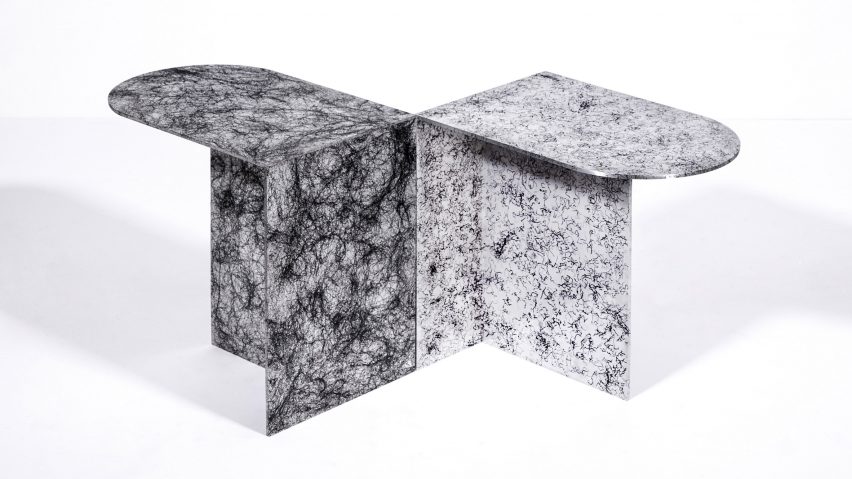London-based designers Fabio Hendry and Martijn Rigters have used burnt human hair to create patterns on aluminium stools, which they are presenting at this year's IMM Cologne furniture fair.
Hendry and Rigters developed their own technique for transforming the abundant natural material into a sustainable ink for printing patterns on metal.
The duo chose human hair, allowing them to use offcuts from local hairdressers. They then referenced both old ceramic techniques and modern printing techniques – like etching and screen printing – to refine their process.
"For us it was important that we have a constant material supply," Hendry told Dezeen. "There are plenty of hairdressers so the material supply is aways guaranteed."
"We've developed this technique that we can create patterns on different types of metals."
Called The Colour of Hair, the stools feature seats with curved edges, and uprights that extend down from two edges.
During manufacture, all of these parts are placed inside a reconfigured industrial barbecue grill for 10 minutes.
Hair is then applied to each of the heated panels for five to 10 seconds, carbonising instantly so that it acts as a form of ink that has similarities to etching and anodising. Afterwards, the sheets are rinsed and cooled.
The reaction is caused by the hair's main protein, keratin. The transformation during the process is permanent and durable.
"We use proteins as a printing matter, and in our case we've been using hair because hair is a protein and the largest part of this protein is keratin, so it works even better," Hendry explained.
"We heat up the aluminium for five minutes and then after these five minutes we apply hair onto it and when the hair touches the hot surface it carbonises, which means it sorts of liquifies and penetrates the aluminium and leaves an imprint, but the hair dissolves on this impact, so there's no hair there anymore," he continued.
This is not the first time that leftover human hair has been recycled by designers. Zsofia Kollar used it to create a series of scented objects, including a wall hanging and a U-shaped necklace, while Ola Giertz stuffed clumps into plastic pouffes for padding.
Hendry and Rigters have developed five different techniques using a range of hair lengths to create a variety of patterns for the stools, as well as counters, shelves and tiles.
One involves trimming short hair to create a fine powder. This is pushed through a sheet material with holes, similar to screen-printing, leaving an imprint identical to the template.
"We trim the hair into very fine powder and this powder we treat as ink," Hendry explained. "We push through a stencil and we get a negative of the image."
"Any digital image can be transformed into a rasterised vector or bitmap, which can then be cut out by laser, or transformed with an emulsion onto metal-mesh in order to make the stencil."
Hair shavings are applied by directly sieving hair fibres through multiple meshes with different hole sizes. The longer the sprinkle, the darker the prints get, allowing for different colour gradients.
Medium length hair stands can be used to create a marble pattern. The hair is evenly distributed onto a backing paper and sprayed with a liquid mixture of hair-gel and water.
It is then pressed in a heat press for two minutes into a flat sheet. The gel hardens and the water dissolves, creating a strong joint where the single hair-fibres overlap.
The denser the distribution of hair, the more marbled the print becomes. The fabric made of hair is roughly 40-by-40 centimetres and called hair papyrus.
In another technique, longer hair fibres are tied as a bunch and attached to a handle to create different types of brush, each with different strokes. Wide brushes make it possible to paint large tiles and fully cover a surface.
What's important in the process is that it has to go quite quick, hair papyrus, so you have these hair sheets and those you have to apply on and it makes this nice marble effect," said Hendry.
A lock pattern can also be created from a cut of ponytail, which is directly distributed onto the metal surface, leaving spherical patches.
IMM Cologne takes place from 16 to 22 January 2017. Other products launching at the fair include a collection of tables by architect Hans Bølling and tinted glass shelving that can be customised online by Werner Aisslinger.
Also on show is this year's Das Haus installation, which Todd Bracher designed to challenge typical home organisation.

